A feature - Based model for nested named-entity recognition at vlsp - 2018 ner evaluation campaign
Named-entity recognition (NER) is an important task in information extraction. The task is to
identify in a text, spans that are entities and classify them into pre-defined categories. There have
been some conferences and shared tasks for evaluating NER systems in English and other languages,
such as MUC- [17], CoNLL 2002 [15] and CoNLL 2003 [16].
In Vietnamese language, VLSP 2016 NER evaluation campaign [3] is the first evaluation campaign
that aims to systematically compare NER systems for Vietnamese language. Similar to CoNLL 2003
shared-task, in VLSP 2016, four named-entity types were considered: person (PER), organization
(ORG), location (LOC), and miscellaneous entities (MISC). In VLSP 2016, organizers provided the
training/test data with gold word segmentation, PoS and chunking tags. While that setting can help
participant teams to reduce effort of data processing and solely focus on developing NER algorithms,
it is not a realistic setting. In VLSP 2018 NER evaluation campaign, only raw texts with XML tags
were provided. Therefore, we need to choose appropriate Vietnamese NLP tools for preprocessing
steps such as word segmentation, PoS tagging, and chunking. VLSP 2018 NER campaign also differs
from VLSP 2016 NER campaign in that the official evaluation considers nested named-entities of all
levels.
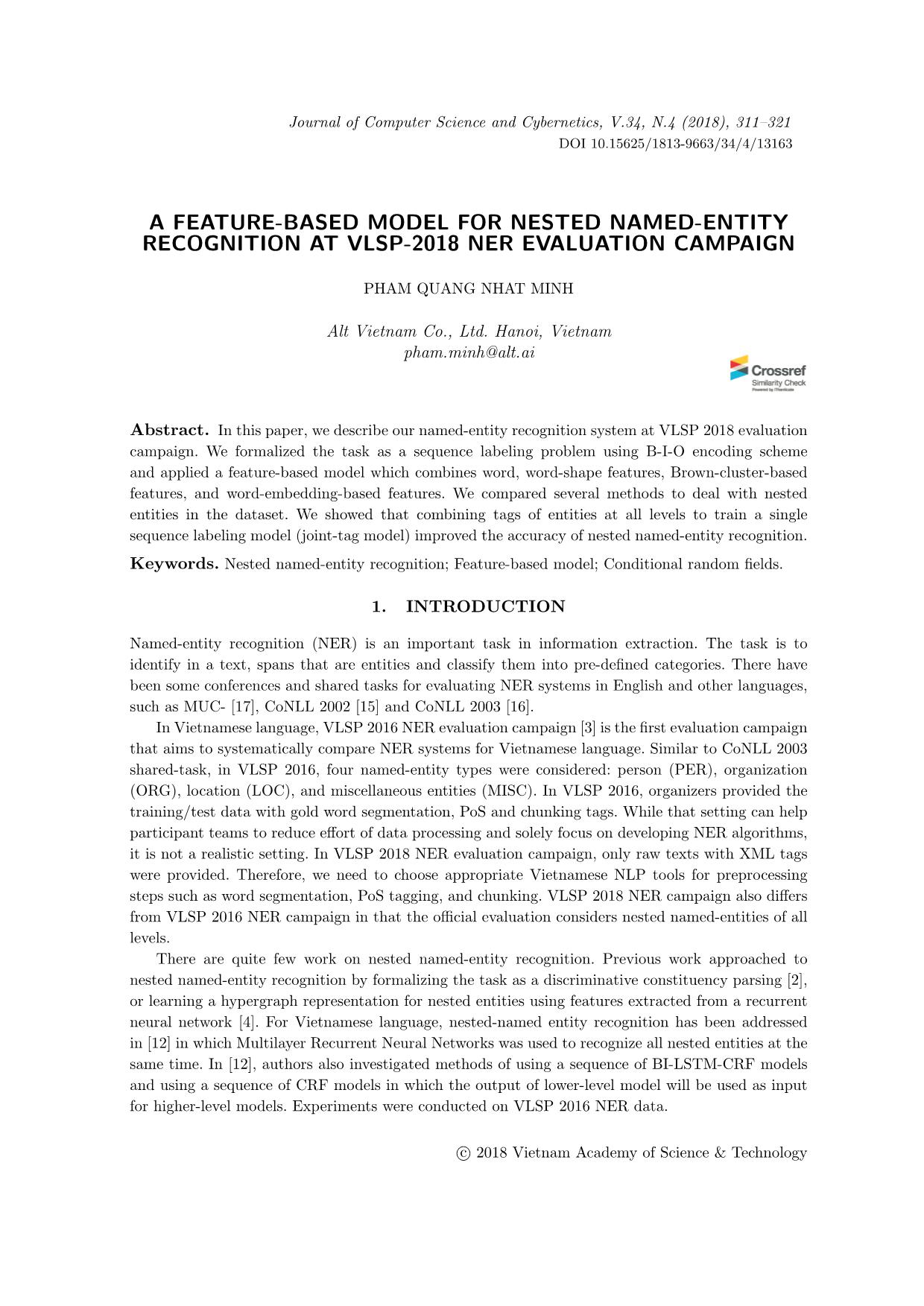
Trang 1
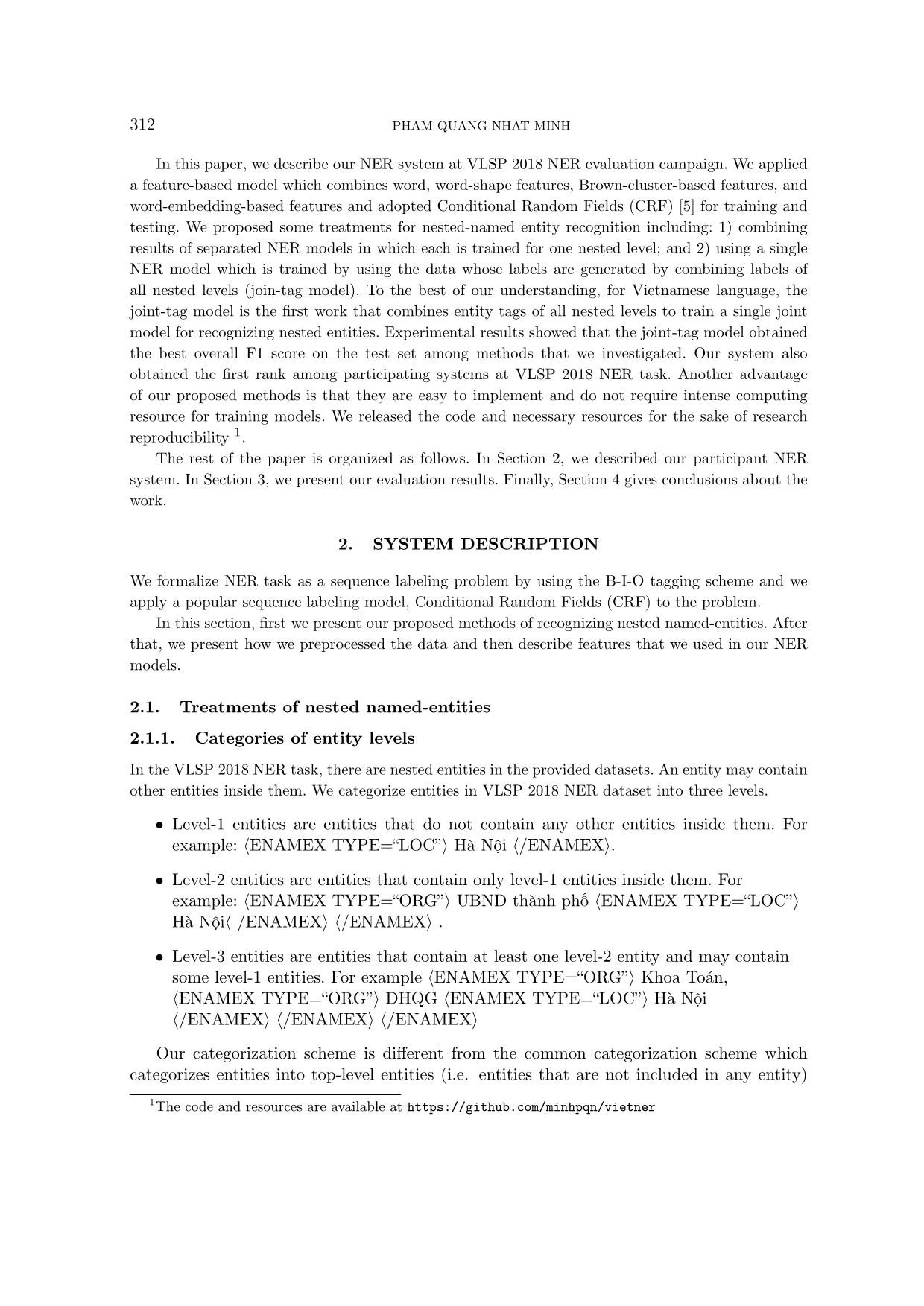
Trang 2
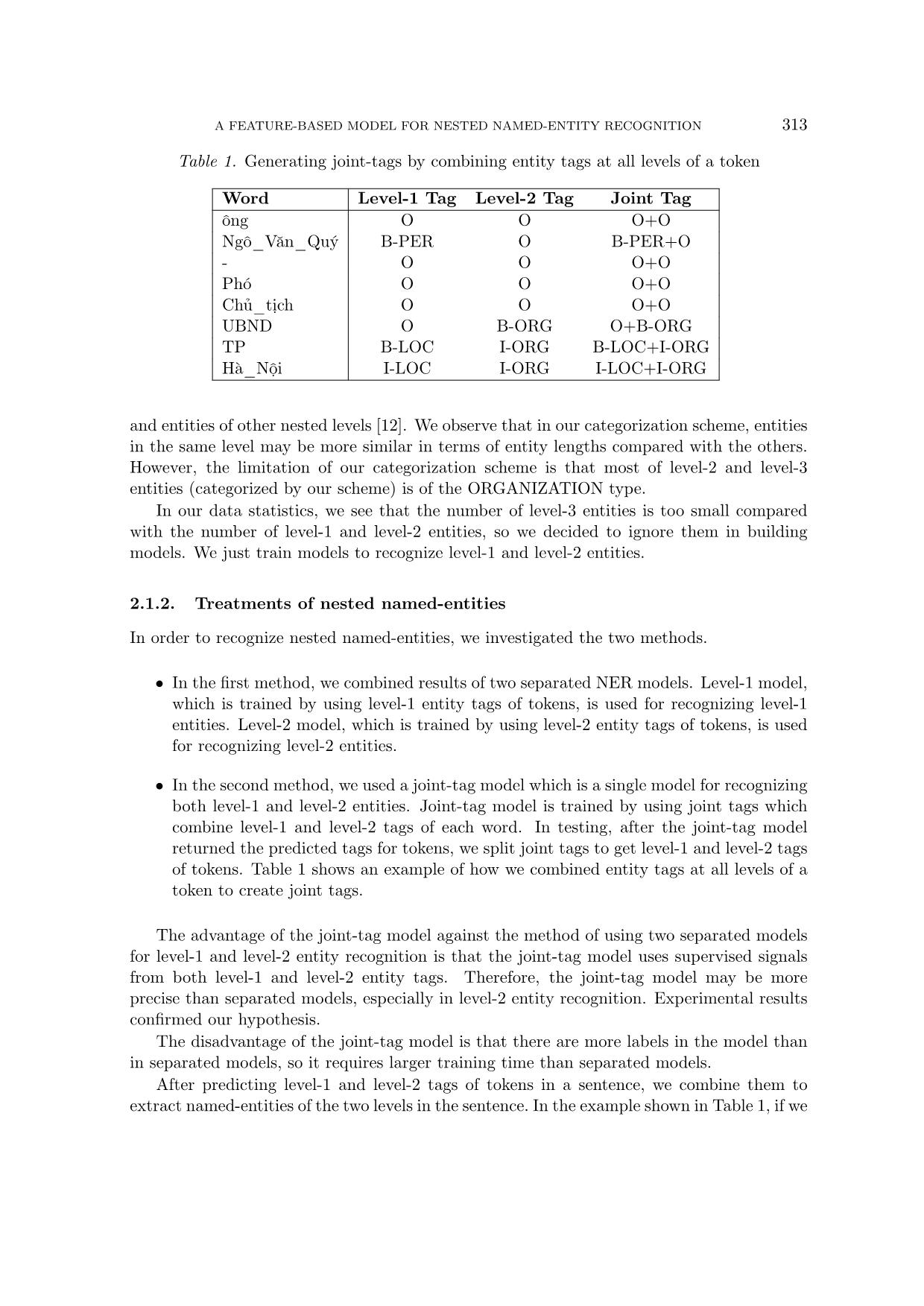
Trang 3
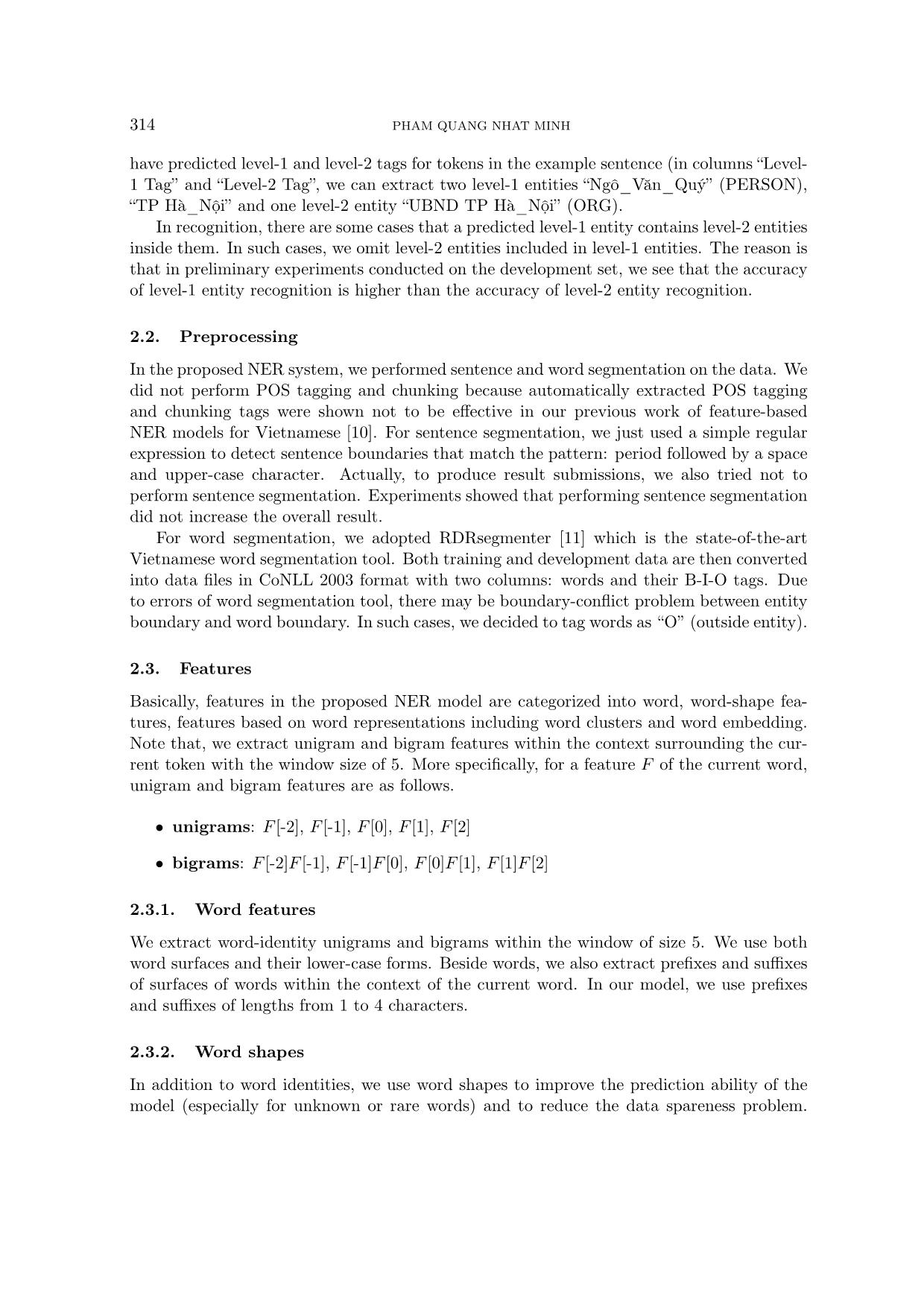
Trang 4
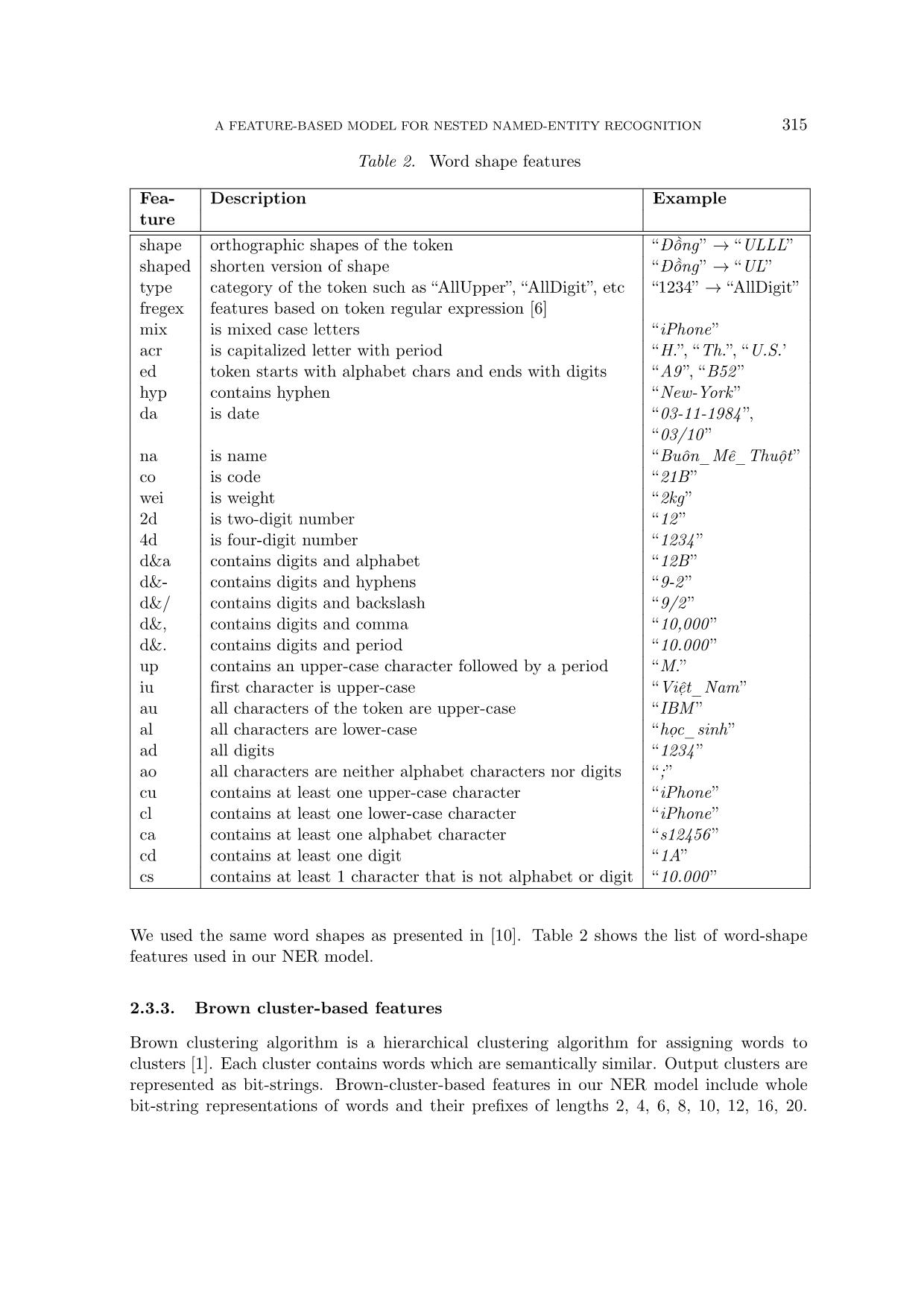
Trang 5
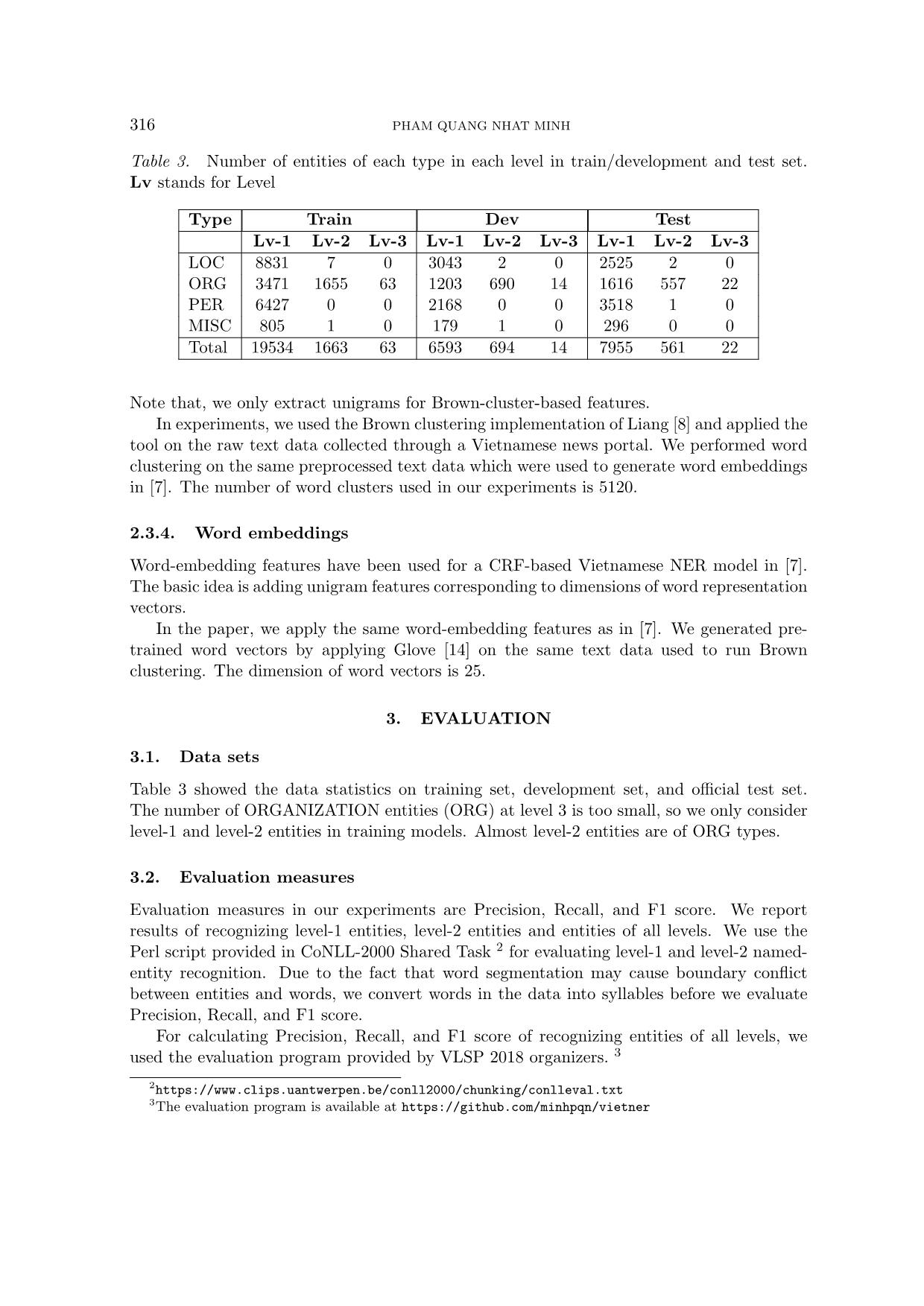
Trang 6
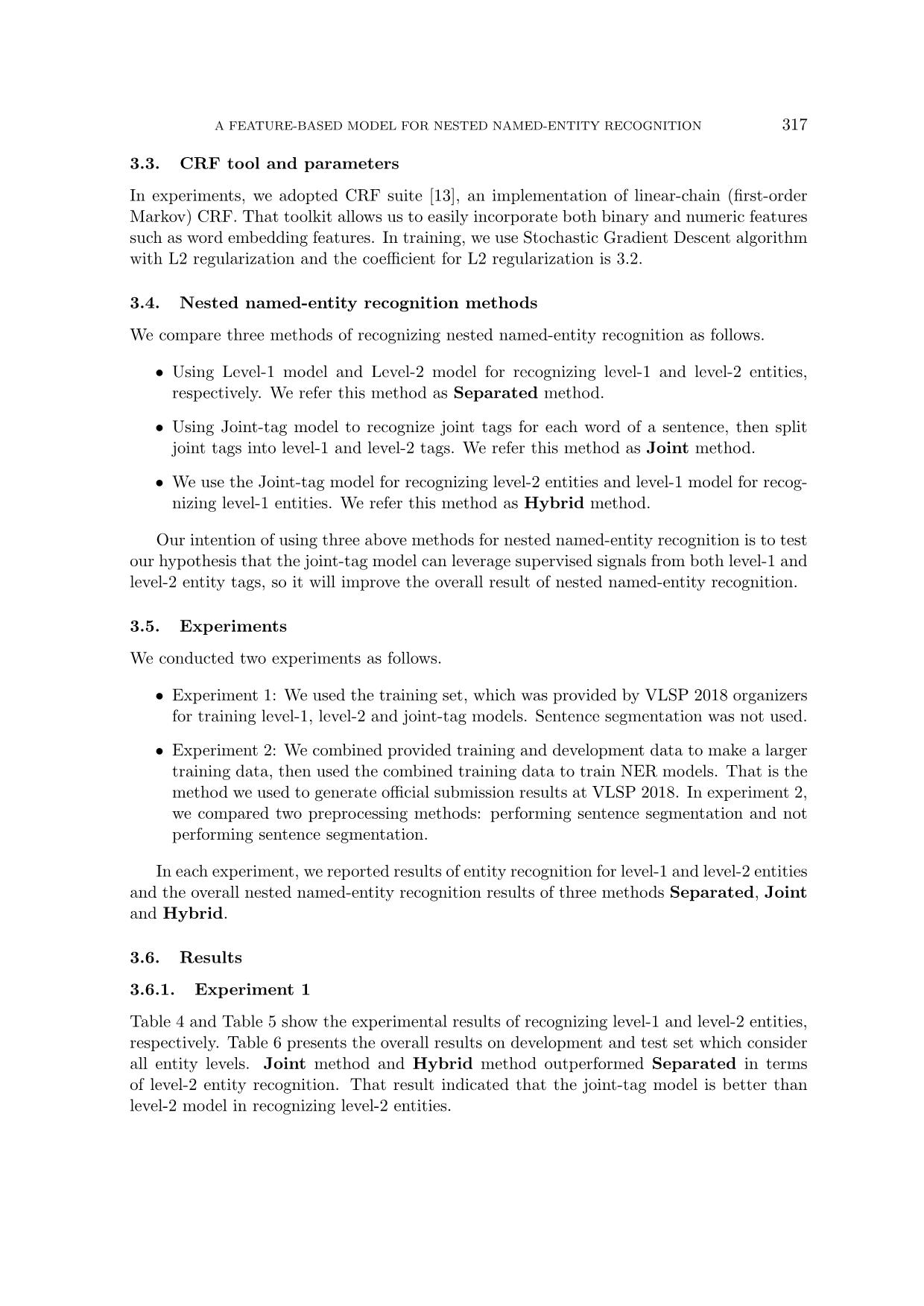
Trang 7
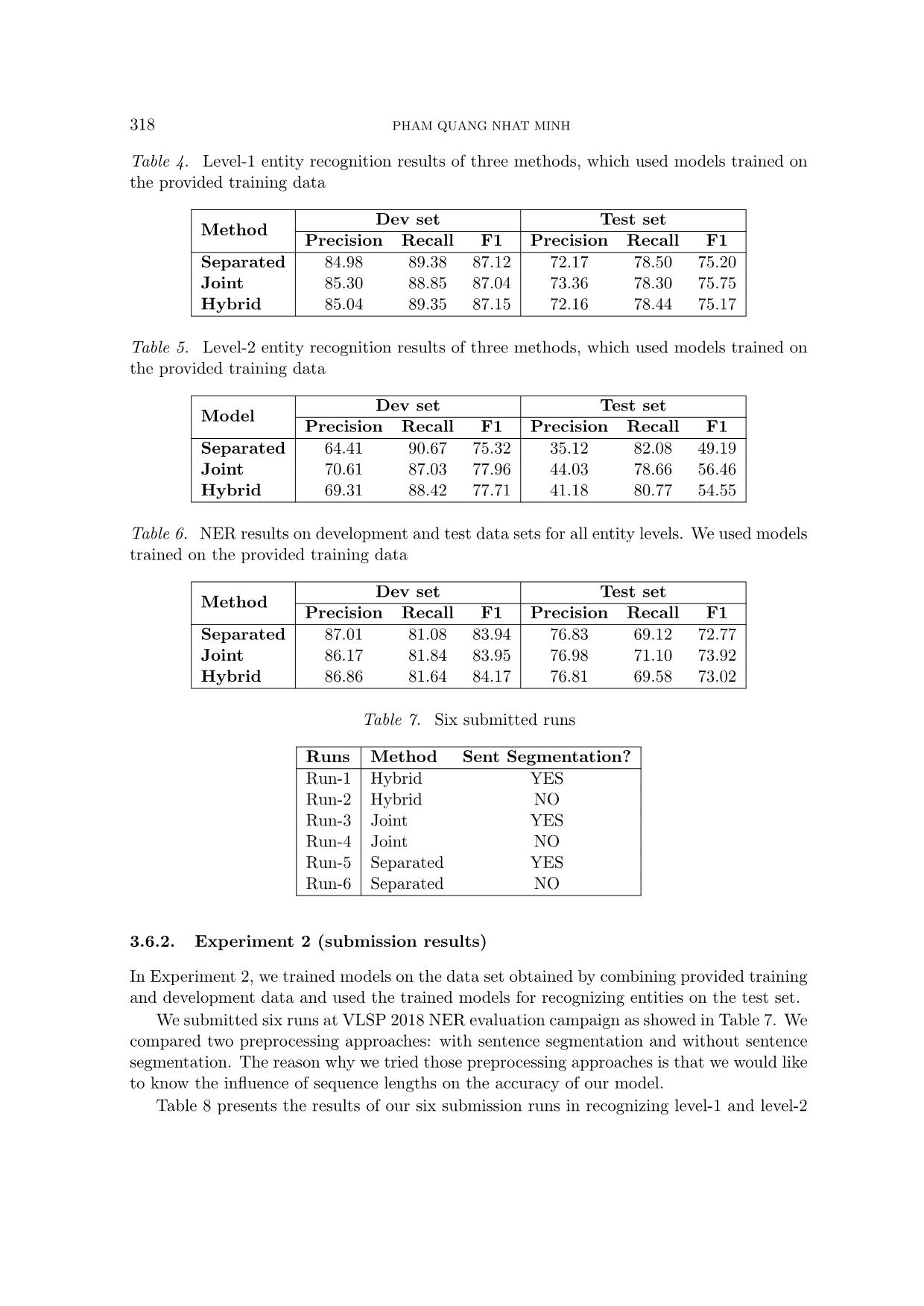
Trang 8

Trang 9
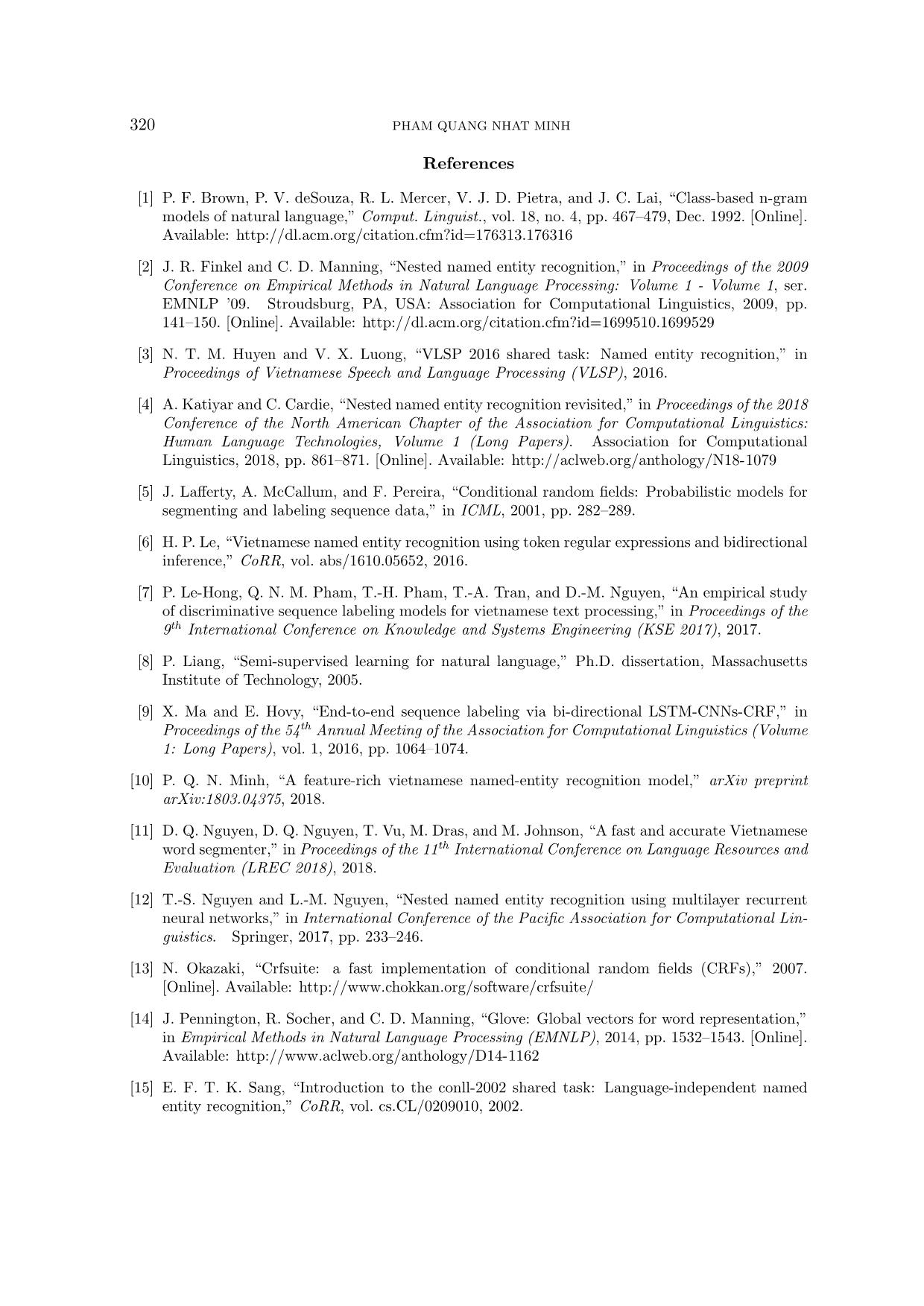
Trang 10
Tải về để xem bản đầy đủ
Tóm tắt nội dung tài liệu: A feature - Based model for nested named-entity recognition at vlsp - 2018 ner evaluation campaign
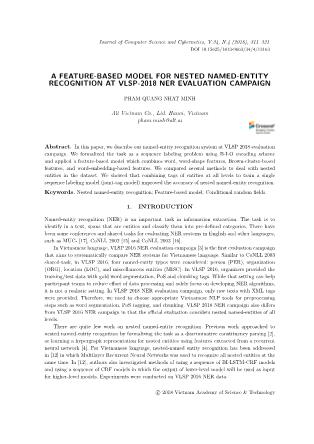
words within the context of the current word. In our model, we use prefixes and suffixes of lengths from 1 to 4 characters. 2.3.2. Word shapes In addition to word identities, we use word shapes to improve the prediction ability of the model (especially for unknown or rare words) and to reduce the data spareness problem. A FEATURE-BASED MODEL FOR NESTED NAMED-ENTITY RECOGNITION 315 Table 2. Word shape features Fea- Description Example ture shape orthographic shapes of the token “Đồng” → “ULLL” shaped shorten version of shape “Đồng” → “UL” type category of the token such as “AllUpper”, “AllDigit”, etc “1234” → “AllDigit” fregex features based on token regular expression [6] mix is mixed case letters “iPhone” acr is capitalized letter with period “H.”, “Th.”, “U.S.’ ed token starts with alphabet chars and ends with digits “A9 ”, “B52 ” hyp contains hyphen “New-York ” da is date “03-11-1984 ”, “03/10 ” na is name “Buôn_Mê_Thuột” co is code “21B ” wei is weight “2kg” 2d is two-digit number “12 ” 4d is four-digit number “1234 ” d&a contains digits and alphabet “12B ” d&- contains digits and hyphens “9-2 ” d&/ contains digits and backslash “9/2 ” d&, contains digits and comma “10,000 ” d&. contains digits and period “10.000 ” up contains an upper-case character followed by a period “M.” iu first character is upper-case “Việt_Nam” au all characters of the token are upper-case “IBM ” al all characters are lower-case “học_sinh” ad all digits “1234 ” ao all characters are neither alphabet characters nor digits “;” cu contains at least one upper-case character “iPhone” cl contains at least one lower-case character “iPhone” ca contains at least one alphabet character “s12456 ” cd contains at least one digit “1A” cs contains at least 1 character that is not alphabet or digit “10.000 ” We used the same word shapes as presented in [10]. Table 2 shows the list of word-shape features used in our NER model. 2.3.3. Brown cluster-based features Brown clustering algorithm is a hierarchical clustering algorithm for assigning words to clusters [1]. Each cluster contains words which are semantically similar. Output clusters are represented as bit-strings. Brown-cluster-based features in our NER model include whole bit-string representations of words and their prefixes of lengths 2, 4, 6, 8, 10, 12, 16, 20. 316 PHAM QUANG NHAT MINH Table 3. Number of entities of each type in each level in train/development and test set. Lv stands for Level Type Train Dev Test Lv-1 Lv-2 Lv-3 Lv-1 Lv-2 Lv-3 Lv-1 Lv-2 Lv-3 LOC 8831 7 0 3043 2 0 2525 2 0 ORG 3471 1655 63 1203 690 14 1616 557 22 PER 6427 0 0 2168 0 0 3518 1 0 MISC 805 1 0 179 1 0 296 0 0 Total 19534 1663 63 6593 694 14 7955 561 22 Note that, we only extract unigrams for Brown-cluster-based features. In experiments, we used the Brown clustering implementation of Liang [8] and applied the tool on the raw text data collected through a Vietnamese news portal. We performed word clustering on the same preprocessed text data which were used to generate word embeddings in [7]. The number of word clusters used in our experiments is 5120. 2.3.4. Word embeddings Word-embedding features have been used for a CRF-based Vietnamese NER model in [7]. The basic idea is adding unigram features corresponding to dimensions of word representation vectors. In the paper, we apply the same word-embedding features as in [7]. We generated pre- trained word vectors by applying Glove [14] on the same text data used to run Brown clustering. The dimension of word vectors is 25. 3. EVALUATION 3.1. Data sets Table 3 showed the data statistics on training set, development set, and official test set. The number of ORGANIZATION entities (ORG) at level 3 is too small, so we only consider level-1 and level-2 entities in training models. Almost level-2 entities are of ORG types. 3.2. Evaluation measures Evaluation measures in our experiments are Precision, Recall, and F1 score. We report results of recognizing level-1 entities, level-2 entities and entities of all levels. We use the Perl script provided in CoNLL-2000 Shared Task 2 for evaluating level-1 and level-2 named- entity recognition. Due to the fact that word segmentation may cause boundary conflict between entities and words, we convert words in the data into syllables before we evaluate Precision, Recall, and F1 score. For calculating Precision, Recall, and F1 score of recognizing entities of all levels, we used the evaluation program provided by VLSP 2018 organizers. 3 2https://www.clips.uantwerpen.be/conll2000/chunking/conlleval.txt 3The evaluation program is available at https://github.com/minhpqn/vietner A FEATURE-BASED MODEL FOR NESTED NAMED-ENTITY RECOGNITION 317 3.3. CRF tool and parameters In experiments, we adopted CRF suite [13], an implementation of linear-chain (first-order Markov) CRF. That toolkit allows us to easily incorporate both binary and numeric features such as word embedding features. In training, we use Stochastic Gradient Descent algorithm with L2 regularization and the coefficient for L2 regularization is 3.2. 3.4. Nested named-entity recognition methods We compare three methods of recognizing nested named-entity recognition as follows. • Using Level-1 model and Level-2 model for recognizing level-1 and level-2 entities, respectively. We refer this method as Separated method. • Using Joint-tag model to recognize joint tags for each word of a sentence, then split joint tags into level-1 and level-2 tags. We refer this method as Joint method. • We use the Joint-tag model for recognizing level-2 entities and level-1 model for recog- nizing level-1 entities. We refer this method as Hybrid method. Our intention of using three above methods for nested named-entity recognition is to test our hypothesis that the joint-tag model can leverage supervised signals from both level-1 and level-2 entity tags, so it will improve the overall result of nested named-entity recognition. 3.5. Experiments We conducted two experiments as follows. • Experiment 1: We used the training set, which was provided by VLSP 2018 organizers for training level-1, level-2 and joint-tag models. Sentence segmentation was not used. • Experiment 2: We combined provided training and development data to make a larger training data, then used the combined training data to train NER models. That is the method we used to generate official submission results at VLSP 2018. In experiment 2, we compared two preprocessing methods: performing sentence segmentation and not performing sentence segmentation. In each experiment, we reported results of entity recognition for level-1 and level-2 entities and the overall nested named-entity recognition results of three methods Separated, Joint and Hybrid. 3.6. Results 3.6.1. Experiment 1 Table 4 and Table 5 show the experimental results of recognizing level-1 and level-2 entities, respectively. Table 6 presents the overall results on development and test set which consider all entity levels. Joint method and Hybrid method outperformed Separated in terms of level-2 entity recognition. That result indicated that the joint-tag model is better than level-2 model in recognizing level-2 entities. 318 PHAM QUANG NHAT MINH Table 4. Level-1 entity recognition results of three methods, which used models trained on the provided training data Method Dev set Test set Precision Recall F1 Precision Recall F1 Separated 84.98 89.38 87.12 72.17 78.50 75.20 Joint 85.30 88.85 87.04 73.36 78.30 75.75 Hybrid 85.04 89.35 87.15 72.16 78.44 75.17 Table 5. Level-2 entity recognition results of three methods, which used models trained on the provided training data Model Dev set Test set Precision Recall F1 Precision Recall F1 Separated 64.41 90.67 75.32 35.12 82.08 49.19 Joint 70.61 87.03 77.96 44.03 78.66 56.46 Hybrid 69.31 88.42 77.71 41.18 80.77 54.55 Table 6. NER results on development and test data sets for all entity levels. We used models trained on the provided training data Method Dev set Test set Precision Recall F1 Precision Recall F1 Separated 87.01 81.08 83.94 76.83 69.12 72.77 Joint 86.17 81.84 83.95 76.98 71.10 73.92 Hybrid 86.86 81.64 84.17 76.81 69.58 73.02 Table 7. Six submitted runs Runs Method Sent Segmentation? Run-1 Hybrid YES Run-2 Hybrid NO Run-3 Joint YES Run-4 Joint NO Run-5 Separated YES Run-6 Separated NO 3.6.2. Experiment 2 (submission results) In Experiment 2, we trained models on the data set obtained by combining provided training and development data and used the trained models for recognizing entities on the test set. We submitted six runs at VLSP 2018 NER evaluation campaign as showed in Table 7. We compared two preprocessing approaches: with sentence segmentation and without sentence segmentation. The reason why we tried those preprocessing approaches is that we would like to know the influence of sequence lengths on the accuracy of our model. Table 8 presents the results of our six submission runs in recognizing level-1 and level-2 A FEATURE-BASED MODEL FOR NESTED NAMED-ENTITY RECOGNITION 319 Table 8. Evaluation results of recognizing level-1 entities and level-2 entities on the test set of the six submission runs Method Level-1 Entity Level-2 Entity Precision Recall F1 Precision Recall F1 Run-1 (Hybrid + SentSeg) 73.82 79.43 76.52 43.32 82.94 56.91 Run-2 (Hybrid) 73.45 80.04 76.60 43.14 82.59 56.67 Run-3 (Joint + SentSeg) 73.21 79.56 76.26 45.28 81.41 58.19 Run-4 (Joint) 73.95 79.33 76.55 44.56 82.51 57.87 Run-5 (Separated + SentSeg) 73.80 79.46 76.53 39.39 83.08 53.45 Run-6 (Separated) 73.46 80.08 76.63 36.90 84.15 51.30 Table 9. Official evaluation results on test set of our six submitted runs for nested-named entity recognition Run Precision Recall F1 Run-1 (Hybrid + SentSeg) 77.85 71.08 74.31 Run-2 (Hybrid) 78.32 70.88 74.41 Run-3 (Joint + SentSeg) 78.07 70.98 74.35 Run-4 (Joint) 78.0 71.69 74.70 Run-5 (Separated + SentSeg) 77.83 70.78 74.14 Run-6 (Separated) 78.35 70.44 74.19 entities. While for F1 scores of six runs for level-1 entity recognition are very close, Joint method outperformed the other methods in recognizing level-2 entities. Table 9 shows the official evaluation results for our six submitted runs. As indicated in the table, run 4 which uses Joint model obtained the highest F1 score among six runs. Using Joint method or Hybrid method obtained better F1 scores than using Separated methods. We also see that the difference between a system that performs sentence segmentation and a system that does not perform sentence segmentation is very small. The reason why Joint method and Hybrid method obtained better F1 scores than Separated method is that both Joint an Hybrid methods used joint-tag model while Separated method used level-2 model to recognize level-2 entities. We already pointed out that joint-tag model outperforms level-2 model in level-2 entity recognition. 4. CONCLUSIONS We presented a feature-based model for Vietnamese named-entity recognition and evalua- tion results at VLSP 2018 NER evaluation campaign. We compared several methods for recognizing nested entities. Experimental results showed that combining tags of entities at all levels for training a sequence labeling model improved the accuracy of nested named- entity recognition. As the future work, we plan to investigate deep learning methods such as BiLSTM-CNN-CRF [9] for nested named entity recognition. 320 PHAM QUANG NHAT MINH References [1] P. F. Brown, P. V. deSouza, R. L. Mercer, V. J. D. Pietra, and J. C. Lai, “Class-based n-gram models of natural language,” Comput. Linguist., vol. 18, no. 4, pp. 467–479, Dec. 1992. [Online]. Available: [2] J. R. Finkel and C. D. Manning, “Nested named entity recognition,” in Proceedings of the 2009 Conference on Empirical Methods in Natural Language Processing: Volume 1 - Volume 1, ser. EMNLP ’09. Stroudsburg, PA, USA: Association for Computational Linguistics, 2009, pp. 141–150. [Online]. Available: [3] N. T. M. Huyen and V. X. Luong, “VLSP 2016 shared task: Named entity recognition,” in Proceedings of Vietnamese Speech and Language Processing (VLSP), 2016. [4] A. Katiyar and C. Cardie, “Nested named entity recognition revisited,” in Proceedings of the 2018 Conference of the North American Chapter of the Association for Computational Linguistics: Human Language Technologies, Volume 1 (Long Papers). Association for Computational Linguistics, 2018, pp. 861–871. [Online]. Available: [5] J. Lafferty, A. McCallum, and F. Pereira, “Conditional random fields: Probabilistic models for segmenting and labeling sequence data,” in ICML, 2001, pp. 282–289. [6] H. P. Le, “Vietnamese named entity recognition using token regular expressions and bidirectional inference,” CoRR, vol. abs/1610.05652, 2016. [7] P. Le-Hong, Q. N. M. Pham, T.-H. Pham, T.-A. Tran, and D.-M. Nguyen, “An empirical study of discriminative sequence labeling models for vietnamese text processing,” in Proceedings of the 9th International Conference on Knowledge and Systems Engineering (KSE 2017), 2017. [8] P. Liang, “Semi-supervised learning for natural language,” Ph.D. dissertation, Massachusetts Institute of Technology, 2005. [9] X. Ma and E. Hovy, “End-to-end sequence labeling via bi-directional LSTM-CNNs-CRF,” in Proceedings of the 54th Annual Meeting of the Association for Computational Linguistics (Volume 1: Long Papers), vol. 1, 2016, pp. 1064–1074. [10] P. Q. N. Minh, “A feature-rich vietnamese named-entity recognition model,” arXiv preprint arXiv:1803.04375, 2018. [11] D. Q. Nguyen, D. Q. Nguyen, T. Vu, M. Dras, and M. Johnson, “A fast and accurate Vietnamese word segmenter,” in Proceedings of the 11th International Conference on Language Resources and Evaluation (LREC 2018), 2018. [12] T.-S. Nguyen and L.-M. Nguyen, “Nested named entity recognition using multilayer recurrent neural networks,” in International Conference of the Pacific Association for Computational Lin- guistics. Springer, 2017, pp. 233–246. [13] N. Okazaki, “Crfsuite: a fast implementation of conditional random fields (CRFs),” 2007. [Online]. Available: [14] J. Pennington, R. Socher, and C. D. Manning, “Glove: Global vectors for word representation,” in Empirical Methods in Natural Language Processing (EMNLP), 2014, pp. 1532–1543. [Online]. Available: [15] E. F. T. K. Sang, “Introduction to the conll-2002 shared task: Language-independent named entity recognition,” CoRR, vol. cs.CL/0209010, 2002. A FEATURE-BASED MODEL FOR NESTED NAMED-ENTITY RECOGNITION 321 [16] E. F. T. K. Sang and F. D. Meulder, “Introduction to the conll-2003 shared task: Language- independent named entity recognition,” in CoNLL, 2003. [17] B. Sundheim, “Overview of results of the muc-6 evaluation,” in MUC, 1995. Received on October 03, 2018 Revised on December 28, 2018
File đính kèm:
 a_feature_based_model_for_nested_named_entity_recognition_at.pdf
a_feature_based_model_for_nested_named_entity_recognition_at.pdf

